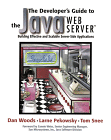More Than Just Another Java Web Server Book
Informative for servlet and JSP developers, good exploration of development, testing, deployment, administration.
ORIGINAL DRAFT
The Java Web Server is an interesting paradox. Early out of the gate, it was the first application to demonstrate the power of server-side Java. Despite its solid design, reliability and early implementations of Servlets and JSP, it achieved only limited adoption. Yet the concepts shared by this web application server are now widespread, so the concepts explored in this book tend to apply more widely than the title might suggest. For anyone doing servlet or JSP development, this book can help. This is also the only book that can tell you how to build a JWS service, among other things, so it’ll be even more important to anyone using the JWS in a production environment.
The book is divided into 5 parts, with 22 chapters and one appendix. Part I lays a foundation by presenting the big picture and a sample game application in two chapters. Part 2 looks at administrative features, working with servlets, HTML templates, log files, Java Server Pages, sessions, internationalization and localization options. The internationalization and localization chapter touches on areas that are seldom explored in books that cover servlet programming. Part III is about coding techniques, with a close look at the servlet API, writing thread-safe code, and optimization. Also in this part of the book are chapters on communicating with sockets and mail, using JDBC and using RMI, CORBA or DCOM to communicate with external objects.
Part IV is a great exploration of pragmatic deployment issues addressed as design techniques, debugging and stress testing and performance tuning chapters. If you work with a quality assurance team, this information is very useful for both developers and test engineers. There’s a great deal of information here that typically remains unexplored in servlet development books. Part V provides even more of this kind of information, but this part pertains to the Java Web Server itself. Chapter 20 looks at the security API and creating custom Realms. Chapter 21 takes a close look at logging and Chapter 22 shows you how to extend the Java Web Server with your own services that capitalize on the existing infrastructure. The book closes with an appendix that points the reader to other useful information sources.
Having developed and used the Java Web Server in a production environment, I found this book quite useful, but its clearly useful to servlet developers not highly-depended on the JWS. The chapters on servlet or JSP development, debugging, stress testing and so on are virtually independent of the JWS. In fact, about two thirds of this book should appeal to application server developers using servlets on any platform, with the other third providing insights into JWS that are effectively unavailable anywhere else. If you’re working with any of these technologies, this book delivers good value.
